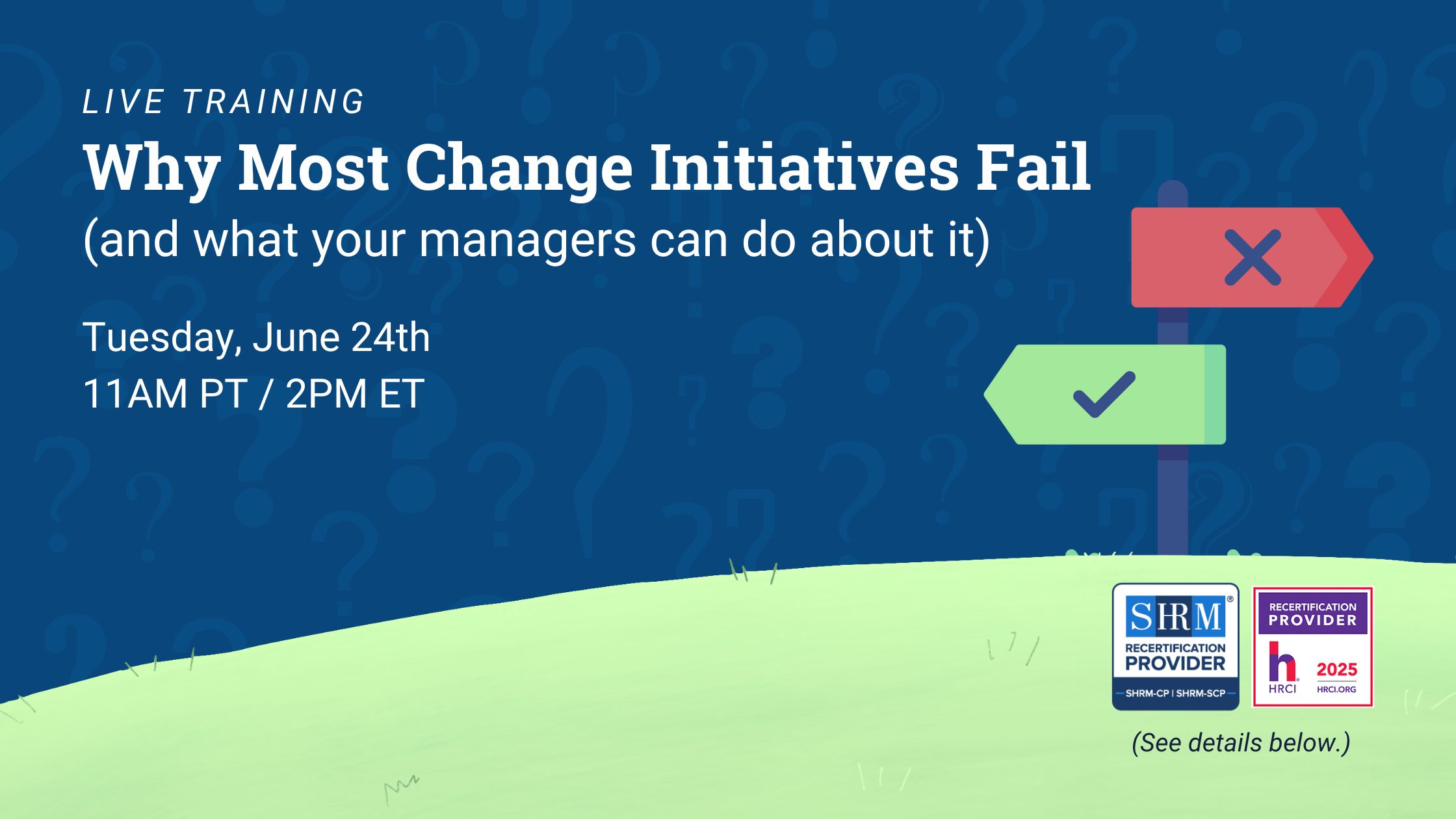Organizations sometimes face the challenging situation of having to lay off employees due to financial constraints, restructuring, or downsizing. While layoffs are often unavoidable, they can have a significant impact on the remaining employees as they face uncertainty, loss, and increased workloads. This can cause further employee turnover. However, employers can take proactive measures to prevent employee turnover and mitigate the negative effects of a layoff. In this blog post, we will explore:
- What is employee turnover?
- How employee turnover can negatively impact a workplace
- How turnover contagion happens
- Four effective strategies to prevent turnover contagion after layoffs
What Is Employee Turnover?
Employee turnover refers to the process of employees leaving their jobs. There are two types of employee turnover: voluntary and involuntary.
Voluntary turnover
Voluntary employee turnover refers to the process of employees leaving a job of their own free will. This type of turnover can occur for a variety of reasons, including lack of career growth opportunities, personal reasons, dissatisfaction with the job or the company, or a desire to pursue a different career path. Some voluntary turnover is expected in any business, but when it happens in large numbers or often, it’s worth investigating what may be causing employees to leave. It can also become prevalent following a layoff, with the spread of low morale and fear among remaining workers. This increased attrition is called “turnover contagion.”
Involuntary turnover
Involuntary employee turnover refers to the process of the removal of employees by a company. Situations where a company asks employees to leave, such as layoffs and termination with cause, are examples of involuntary turnover.
 How Employee Turnover Can Negatively Impact a Workplace
How Employee Turnover Can Negatively Impact a Workplace
Voluntary turnover can have both positive and negative effects on an organization. On the one hand, it can lead to fresh perspectives and new talent coming into the company. On the other hand, it can result in the loss of valuable knowledge and experience, as well as increased costs associated with recruitment and training of new employees.
Involuntary turnover such as a layoff also can result in the loss of knowledge, but can have more widespread effects on the workforce due to the stress it can impose on employees when they witness their colleagues losing their jobs. Many employees choose to leave following a layoff due to fear over their own job security or the general health of the company. And so layoffs can result in the loss of more employees than originally intended, multiplying the negative impact on those remaining.
Do Layoffs Increase Turnover?
Negative reverberations can be felt at every level of an organization following a layoff. It’s at these moments that employees need the support of their managers, extra time to process the loss of their colleagues, and assurance that their jobs are secure. Yet managers may be experiencing the very same concerns, along with the pressure to produce results with a decreased workforce. Employees may also take layoffs as a sign that company performance may be a longer-term concern. They may worry that there will be more waves of layoffs to come and want to find security in a new position at a different company. When morale is low and employees are short on time, patience, and optimism, engagement and loyalty can nosedive, and one employee after another may exit. This is how turnover contagion happens.
But this phenomenon is preventable when you have a plan to address these inevitable concerns.
4 Effective Strategies to Prevent Turnover Contagion After Layoffs
1. Transparent and timely communication
Layoffs can create anxiety and uncertainty among remaining employees, and rumors and speculations can quickly spread, leading to a toxic work environment. To prevent this, organizations should provide clear and honest communication about the reasons for the layoffs, the impact on the organization, and future plans. Employers should allow their workforce to ask questions in an open environment that ensures every team member hears the same information. It is essential to communicate in a timely manner, both before and after the layoff, to address questions and concerns and provide regular updates. By being transparent and keeping the lines of communication open, organizations can build trust, reduce anxiety, and increase retention.
2. Provide support and resources
Employees who witness their colleagues being laid off may experience survivor guilt, increased workload, and job insecurity—either real or imagined. As a result, they may begin looking for new employment elsewhere. To prevent this, employers should provide support and resources to the remaining employees, such as counseling services, regular check-ins with managers, training programs, career coaching, and workshops on resilience and stress management. Organizations should also consider offering flexible work arrangements and workload adjustments to help these employees manage the changes caused by the layoffs. Lastly, employees can be rewarded in recognition for their extra efforts following a layoff. By acknowledging what employees are experiencing, employers can help employees feel valued, motivated, and committed to the organization.
 3. Career development and growth opportunities
3. Career development and growth opportunities
Employees may be more likely to leave the organization after a layoff if they feel that they no longer have career growth prospects with the company. It can be particularly helpful during these times for employers to focus on providing career development opportunities to the remaining employees to prevent turnover contagion. This can include offering career coaching, training programs, mentoring, job rotation, and cross-functional assignments. Employers can also consider implementing personalized career development programs for each employee, which identify their career goals, resources to meet those goals (such as training and coaching), and potential career paths within the company. By investing in employees’ professional growth and providing them with a clear career path, organizations can ease their worry, increase their job satisfaction and commitment, and reduce the likelihood of them leaving.
4. Survey employees
Determining your employees’ specific concerns—beyond the obvious ones about job security and the future of the company—can help you prioritize strategies for moving forward after a layoff. Some may be worried that they won’t have the skills to perform new duties that have been foisted on them, while others may be concerned that they won’t have the chance to advance. Layoffs often result in restructuring departments, and some workers may feel additional loss as they are moved away from those they previously worked with closely.
While you may have a good guess at why employees are leaving, you won’t know the detailed reasons that may cause employees to leave unless you ask them. Surveys are not only an effective way to glean this information—they also demonstrate that you are interested in what your employees think. Explain to your workforce how the surveys will be used, emphasize that they will be anonymous, and put forth a plan to act on the results. Then, keep your organization updated as changes and/or improvements are made.
Voluntary Employee Turnover Is Preventable
Layoffs can have a significant impact on remaining employees, and organizations need to take proactive measures to prevent them from leaving. By implementing strategies such as transparent and timely communication, providing support and resources, and offering career development and growth opportunities, and surveying workers, organizations can prevent employee turnover and create a supportive environment for their employees. By prioritizing employee well-being and engagement, organizations can navigate the challenges of layoffs successfully and ensure the long-term success and sustainability of their workforce.
Why is it Important to Calculate Turnover Rates?
Turnover rates help employers better understand the health of their organizations. Regularly monitoring how many professionals leave a company can draw attention to potential issues that may go unnoticed, especially if the turnover rate sharply rises between monthly or quarterly calculations. Noticing a decrease in turnover can indicate that your organization is conducting itself appropriately.
For example, work cultures can impact company retention rates. If the number of employees leaving your organization continues to rise, then there may be improvements you can make to the workplace that help employees feel content with their positions. The results of a turnover calculation can reveal if the changes made a positive or negative impact on your business. Supplementing this strategy with employee surveys will take the guesswork out of determining which issues are upsetting your team.
A low turnover rate often translates to having effective hiring policies and quality employee management. Providing your staff with a positive onboarding experience can reduce the likelihood of new hires leaving their positions due to feeling unprepared or unsupported by your organization. The management techniques employers utilize also play a significant role in how long an employee stays with a company.
How to Calculate Employee Turnover
The first step to calculating turnover is to determine the number of employees currently active at your organization at the start of the month and the end of the month. Afterward, find out the total number of professionals who left your company that month.
Then, you need to determine the average number of employees you had for the month by adding the number of employees in the workforce at the beginning and end, before then dividing the total by two. For example, if you had 3,000 employees at the start of the month and 2,500 employees at the end, then your average number of employees would be 2,750 people.
The next step is to divide the total number of employees who had left your organization from its average employee number. Continuing the example from before, let’s say the total of professionals who left your company was 500. You would divide 500 and 2,750 to get 0.18.
Multiply the result of the previous step with 100 in order to get your employee turnover percentage. In this example, multiplying 0.18 by 100 results in 18%. This means the turnover rate for your organization was 18%.
If you want the annual turnover rate for your company, then you would replace the monthly figures in the first step with the number of employees who were part of your company at the start and end of the year.
What is the Cost of Employee Turnover?
While retaining employees is important to sustain the operations of your organization, there are also financial repercussions to consider when needing to replace your employees. Businesses often pay 1.5 to 2 times the amount of an employee’s salary toward turnover costs. Replacing vacant positions is more expensive than maintaining the satisfaction of your team, especially when you consider the costs associated with advertising jobs and training new hires. The productivity of your business may also suffer due to the inexperience of trainees.
Finding resources for improving employee motivation and contentment in the workplace can help reduce turnover and its sizable costs. One way for employers to give their staff positive workplace experiences is to provide them with career development programs and offer regular training. Investing in the development of your professionals can improve their commitment to their positions.
Companies can also use personal assessments like CliftonStrengths to help identify the strengths of their employees. The tests have been shown to improve employee engagement while at work and develop soft skills like collaboration. INTOO helps employers of all sizes with cost-effective solutions for every stage of the employee lifecycle, including candidate experience, career development, and outplacement services. Contact us to learn how we can make a difference for you and your employees.
Robyn Kern is a seasoned business writer who has written in the HR, education, technology, and nonprofit spaces. She writes about topics including outplacement, layoffs, career development, internal mobility, candidate experience, succession planning, talent acquisition, and more, with the goal of surfacing workforce trends and educating the HR community on these key topics. Her work has been featured on hrforhr.org and trainingindustry.com.


 How Employee Turnover Can Negatively Impact a Workplace
How Employee Turnover Can Negatively Impact a Workplace 3. Career development and growth opportunities
3. Career development and growth opportunities








